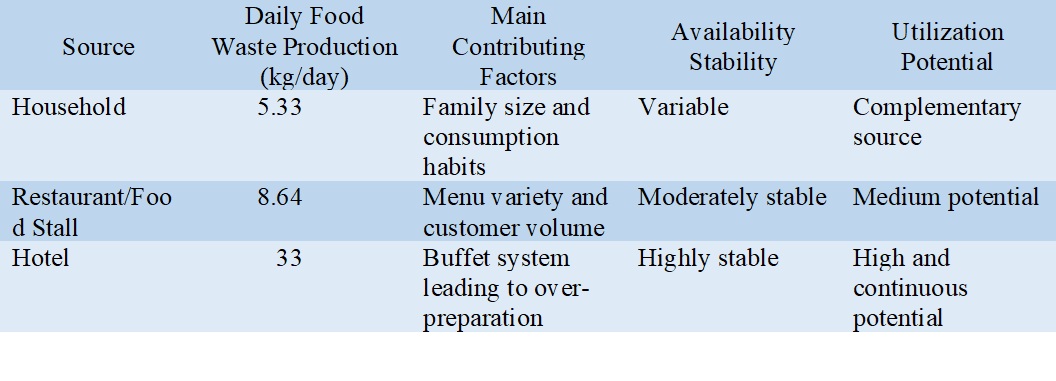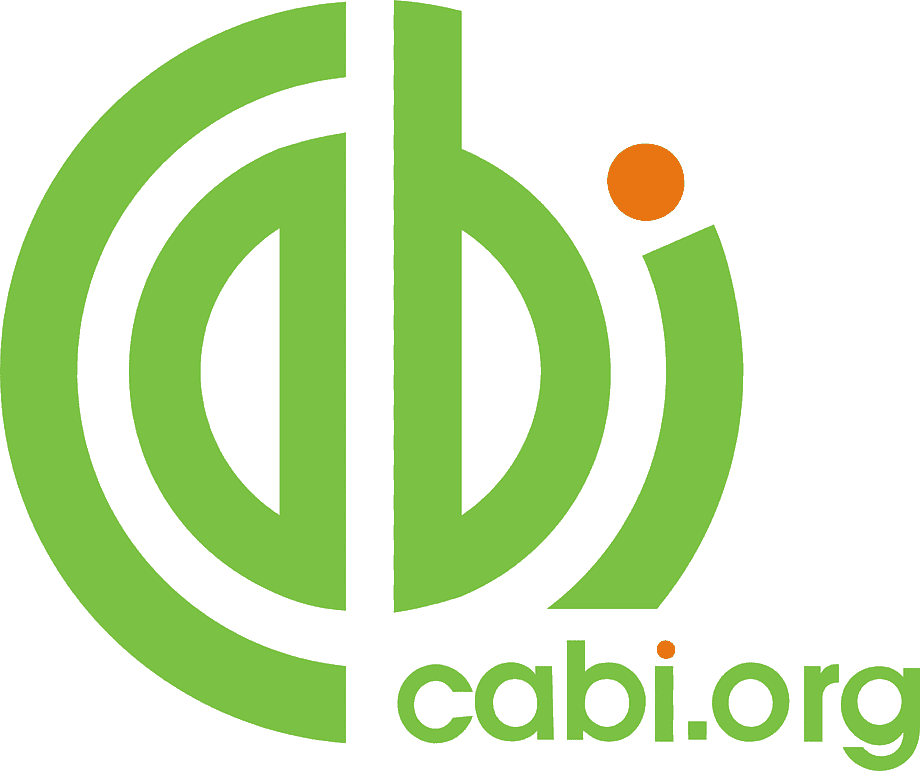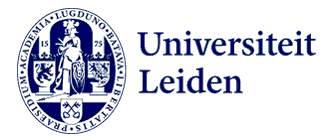The potential of utilizing food waste as pig feed in Sentani District, Jayapura Regency
DOI:
https://doi.org/10.46549/jipvet.v15i2.584Keywords:
Alternative feed, Dry matter, Food waste, Pig farming, SustainabilityAbstract
The increasing demand for sustainable livestock feed sources has sparked interest in the reutilization of food waste. This study aims to assess the quantity, types, and nutritional content of food waste generated from households, restaurants, and hotels in Sentani District, Papua, Indonesia, and evaluate its potential as an alternative feed for pigs. A descriptive mixed-method approach was employed, involving field surveys, structured interviews, and laboratory analysis. Daily food waste production was highest in hotels (33.00 kg/day), followed by restaurants (8.64 kg/day) and households (5.33 kg/day). Nutritional analysis showed that dry matter content was highest in restaurant waste (29.74%), moderate in hotel waste (28.03%), and lowest in household waste (17.19%). The study reveals that hotel and restaurant waste is richer in nutrients and more consistently available, making it a more suitable feed source. However, high moisture content in household waste necessitates prompt handling and processing. These findings highlight the potential of food waste to enhance feed sustainability, reduce costs, and support environmentally responsible livestock practices in rural Papua New Guinea.
Downloads
References
Alba-Reyes Y, Barrera E, Brito-Ibarra Y, Hermida-García F. 2023. Life cycle environmental impacts of using food waste liquid fodder as an alternative for pig feeding in a conventional Cuban farm. The Science of the Total Environment. 858; 159915. https://doi.org/10.1016/j.scitotenv.2022.159915
Baelen C, Montagné L, Ferchaud S, Prunier A, Lebret B. 2024. Feeding strategy in organic pig farming as a lever to improve various quality dimensions of pork. Animal. 18(7); 101190. https://doi.org/10.1016/j.animal.2024.101190
Boumans I, Schop M, Bracke M, Boer I, Gerrits W, Bokkers E. 2022. Feeding food losses and waste to pigs and poultry: Implications for feed quality and production. Journal of Cleaner Production. 378; 134623. https://doi.org/10.1016/j.jclepro.2022.134623
Fenández S, Chávez A, Cuevas R, Tenorio G, Roa‐Morales G. 2023. Life cycle inventory for an organic swine waste treatment system. Journal of Material Cycles and Waste Management. 25(2); 1153–1167. https://doi.org/10.1007/s10163-023-01606-x
Fung L, Urriola P, Shurson G. 2019. Energy, amino acid, and phosphorus digestibility and energy prediction of thermally processed food waste sources for swine. Translational Animal Science. 3(2); 676–691. https://doi.org/10.1093/tas/txz028
Goldáraz-Salamero N, Blanc S, Sierra-Pérez J, Brun F. 2025. From food loss and waste to feed: A systematic review of life cycle perspectives in livestock systems. The International Journal of Life Cycle Assessment. https://doi.org/10.1007/s11367-025-02464-5
Jayathilake N, Aheeyar M, Drechsel P. 2022. Food waste to livestock feed: Prospects and challenges for swine farming in peri-urban Sri Lanka. Circular Economy and Sustainability. 2(4); 1301–1315. https://doi.org/10.1007/s43615-022-00168-8
Matiz-Villamil A, Méndez-Carranza K, Pascagaza-Pulido A, Rendón-Rendón T, Noriega-Noriega J, Pulido-Villamarín A. 2023. Trends in the management of organic swine farm waste by composting: A systematic review. Heliyon. 9(8); e18208. https://doi.org/10.1016/j.heliyon.2023.e18208
Mora-Salguero D, Ranjard L, Morvan T, Dequiedt S, Jean-Baptiste V, Sadet-Bourgeteau S. 2025. Long-term effect of repeated application of pig slurry digestate on microbial communities in arable soils. Heliyon. 11(1); e41117. https://doi.org/10.1016/j.heliyon.2024.e41117
Pinotti L, Luciano A, Ottoboni M, Manoni M, Ferrari L, Marchis D, Tretola M. 2021. Recycling food leftovers in feed as opportunity to increase the sustainability of livestock production. Journal of Cleaner Production. 294; 126290. https://doi.org/10.1016/j.jclepro.2021.126290
Quander-Stoll N, Bautze D, Zollitsch W, Leiber F, Früh B. 2022. Effects of 100% organic feeding on performance, carcass composition and fat quality of fattening pigs. Biological Agriculture & Horticulture. 38(4); 271–284. https://doi.org/10.1080/01448765.2022.2119889
Rajeh C, Saoud I, Kharroubi S, Naalbandian S, Abiad M. 2020. Food loss and food waste recovery as animal feed: A systematic review. Journal of Material Cycles and Waste Management. 23(1); 1–17. https://doi.org/10.1007/s10163-020-01102-6
Salemdeeb R, Ermgassen E, Kim M, Balmford A, Al‐Tabbaa A. 2017. Environmental and health impacts of using food waste as animal feed: A comparative analysis of food waste management options. Journal of Cleaner Production. 140; 871–880. https://doi.org/10.1016/j.jclepro.2016.05.049
Wang Z, Sun G, Wang J, Yang G. 2023. Effect of exogenous additives on heavy metal passivation and nitrogen retention in pig manure composting. Frontiers of Agricultural Science and Engineering. https://doi.org/10.15302/j-fase-2023487

Downloads
Published
How to Cite
Issue
Section
License
Copyright (c) 2025 Max Rumbrapuk, Sientje Daisy Rumetor, Evi W. Saragih

This work is licensed under a Creative Commons Attribution-NonCommercial-ShareAlike 4.0 International License.
License and Copyright Agreement
In submitting the manuscript to the journal, the authors certify that:
- They are authorized by their co-authors to enter into these arrangements.
- The work described has not been formally published before, except in the form of an abstract or as part of a published lecture, review, thesis, or overlay journal. Please also carefully read Jurnal Ilmu Peternakan dan Veteriner Tropis (Journal of Tropical Animal and Veterinary Science) Posting Your Article Policy at https://journal.fapetunipa.ac.id/index.php/JIPVET/publicationethics
- That it is not under consideration for publication elsewhere,
- That its publication has been approved by all the author(s) and by the responsible authorities “tacitly or explicitly“ of the institutes where the work has been carried out.
- They secure the right to reproduce any material that has already been published or copyrighted elsewhere.
- They agree to the following license and copyright agreement.
Copyright
Authors who publish with Jurnal Ilmu Peternakan dan Veteriner Tropis (Journal of Tropical Animal and Veterinary Science) agree to the following terms:
- Authors retain copyright and grant the journal right of first publication with the work simultaneously licensed under a Creative Commons Attribution License (CC BY-NC-SA 4.0) that allows others to share the work with an acknowledgment of the work's authorship and initial publication in this journal.
- Authors are able to enter into separate, additional contractual arrangements for the non-exclusive distribution of the journal's published version of the work (e.g., post it to an institutional repository or publish it in a book), with an acknowledgment of its initial publication in this journal.
- Authors are permitted and encouraged to post their work online (e.g., in institutional repositories or on their website) prior to and during the submission process, as it can lead to productive exchanges, as well as earlier and greater citation of published work.

This work is licensed under a Creative Commons Attribution-NonCommercial-ShareAlike 4.0 International License.




























.png)
